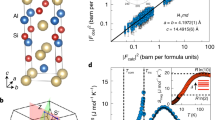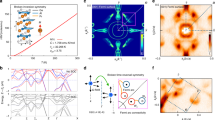Abstract
Weyl points are discrete locations in the three-dimensional momentum space where two bands cross linearly with each other. They serve as the monopoles of Berry curvature in the momentum space, and their existence requires breaking of either time-reversal or inversion symmetry1,2,3,4,5,6,7,8,9,10,11,12,13,14,15,16. Although various non-centrosymmetric Weyl systems have been reported15, demonstration of Weyl degeneracies due to breaking of the time-reversal symmetry remains scarce and is limited to electronic systems17,18. Here, we report the experimental observation of photonic Weyl degeneracies in a magnetized semiconductor—InSb, which behaves as a magnetized plasma19 for electromagnetic waves at the terahertz band. By varying the magnetic field strength, Weyl points and the corresponding photonic Fermi arcs have been demonstrated. Our observation establishes magnetized semiconductors as a reconfigurable20 terahertz Weyl system, which may prompt research on novel magnetic topological phenomena such as chiral Majorana-type edge states and zero modes in classic systems21,22.
This is a preview of subscription content, access via your institution
Access options
Access Nature and 54 other Nature Portfolio journals
Get Nature+, our best-value online-access subscription
$29.99 / 30 days
cancel any time
Subscribe to this journal
Receive 12 print issues and online access
$209.00 per year
only $17.42 per issue
Buy this article
- Purchase on Springer Link
- Instant access to full article PDF
Prices may be subject to local taxes which are calculated during checkout




Similar content being viewed by others
Data availability
The data that support the findings of this study are available from the corresponding authors upon reasonable request.
References
Wan, X., Turner, A. M., Vishwanath, A. & Savrasov, S. Y. Topological semimetal and Fermi-arc surface states in the electronic structure of pyrochlore iridates. Phys. Rev. B 83, 205101 (2011).
Burkov, A. A. & Balents, L. Weyl semimetal in a topological insulator multilayer. Phys. Rev. Lett. 107, 127205 (2011).
Xu, G., Weng, H., Wang, Z., Dai, X. & Fang, Z. Chern semimetal and the quantized anomalous Hall effect in HgCr2Se4. Phys. Rev. Lett. 107, 186806 (2011).
Lu, L., Fu, L., Joannopoulos, J. D. & Soljačić, M. Weyl points and line nodes in gyroid photonic crystals. Nat. Photon. 7, 294–299 (2013).
Xu, S.-Y. et al. Discovery of a Weyl fermion semimetal and topological Fermi arcs. Science 349, 613–617 (2015).
Weng, H., Fang, C., Fang, Z., Bernevig, B. A. & Dai, X. Weyl semimetal phase in noncentrosymmetric transition-metal monophosphides. Phys. Rev. X 5, 011029 (2015).
Lu, L. et al. Experimental observation of Weyl points. Science 349, 622–624 (2015).
Soluyanov, A. A. et al. Type-II Weyl semimetals. Nature 527, 495–498 (2015).
Huang, L. et al. Spectroscopic evidence for a type II Weyl semimetallic state in MoTe2. Nat. Mater. 15, 1155–1160 (2016).
Lin, Q., Xiao, M., Yuan, L. & Fan, S. Photonic Weyl point in a two-dimensional resonator lattice with a synthetic frequency dimension. Nat. Commun. 7, 13731 (2016).
Chang, G. et al. Room-temperature magnetic topological Weyl fermion and nodal line semimetal states in half-metallic Heusler Co2TiX (X = Si, Ge, or Sn). Sci. Rep. 6, 38839 (2016).
Wang, Z. et al. Time-reversal-breaking Weyl fermions in magnetic Heusler alloys. Phys. Rev. Lett. 117, 236401 (2016).
Kübler, J. & Felser, C. Weyl points in the ferromagnetic Heusler compound Co2MnAl. Europhys. Lett. 114, 47005 (2016).
Wang, Q., Xiao, M., Liu, H., Zhu, S. & Chan, C. T. Optical interface states protected by synthetic Weyl points. Phys. Rev. X 7, 031032 (2017).
Armitage, N. P. & Ashvin Vishwanath, E. J. M. Weyl and Dirac semimetals in three-dimensional solids. Rev. Mod. Phys. 90, 015001 (2018).
Ozawa, T. et al. Topological photonics. Rev. Mod. Phys. 91, 015006 (2019).
Borisenko, S. et al. Time-reversal symmetry breaking type-II Weyl state in YbMnBi2. Preprint at https://arxiv.org/abs/1507.04847 (2015).
Liu, E. et al. Giant anomalous Hall effect in a ferromagnetic kagome-lattice semimetal. Nat. Phys. 14, 1125–1131 (2018).
Gao, W. et al. Photonic Weyl degeneracies in magnetized plasma. Nat. Commun. 7, 12435 (2016).
Cheng, X. et al. Robust reconfigurable electromagnetic pathways within a photonic topological insulator. Nat. Mater. 15, 542–548 (2016).
Tan, W., Chen, L., Ji, X. & Lin, H.-Q. Photonic simulation of topological superconductor edge state and zero-energy mode at a vortex. Sci. Rep. 4, 7381 (2014).
Jin, D. et al. Topological magnetoplasmon. Nat. Commun. 7, 13486 (2016).
Goi, E., Yue, Z., Cumming, B. P. & Gu, M. Observation of type I photonic Weyl points in optical frequencies. Laser Photon. Rev. 12, 1700271 (2018).
Chen, W.-J., Xiao, M. & Chan, C. T. Photonic crystals possessing multiple Weyl points and the experimental observation of robust surface states. Nat. Commun. 7, 13038 (2016).
Yang, B. et al. Direct observation of topological surface-state arcs in photonic metamaterials. Nat. Commun. 8, 97 (2017).
Yang, B. et al. Ideal Weyl points and helicoid surface states in artificial photonic crystal structures. Science 359, 1013–1016 (2018).
Noh, J. et al. Experimental observation of optical Weyl points and Fermi arc-like surface states. Nat. Phys. 13, 611–617 (2017).
O’Brien, T. E., Diez, M. & Beenakker, C. W. J. Magnetic breakdown and Klein tunneling in a type-II Weyl semimetal. Phys. Rev. Lett. 116, 236401 (2016).
Liu, C.-X., Ye, P. & Qi, X.-L. Chiral gauge field and axial anomaly in a Weyl semimetal. Phys. Rev. B 87, 235306 (2013).
Kharzeev, D. E., Kikuchi, Y., Meyer, R. & Tanizaki, Y. Giant photocurrent in asymmetric Weyl semimetals from the helical magnetic effect. Phys. Rev. B 98, 014305 (2018).
Yang, Z. et al. Weyl points in a magnetic tetrahedral photonic crystal. Opt. Express 25, 15772–15777 (2017).
Wang, Z., Chong, Y., Joannopoulos, J. D. & Soljačić, M. Observation of unidirectional backscattering-immune topological electromagnetic states. Nature 461, 772–775 (2009).
Poo, Y., Wu, R.-x, Lin, Z., Yang, Y. & Chan, C. T. Experimental realization of self-guiding unidirectional electromagnetic edge states. Phys. Rev. Lett. 106, 093903 (2011).
Morozov, A. I Introduction to Plasma Dynamics. (CRC: 2012).
Zhang, S., Xiong, Y., Bartal, G., Yin, X. & Zhang, X. Magnetized plasma for reconfigurable subdiffraction imaging. Phys. Rev. Lett. 106, 243901 (2011).
Yang, B., Lawrence, M., Gao, W., Guo, Q. & Zhang, S. One-way helical electromagnetic wave propagation supported by magnetized plasma. Sci. Rep. 6, 21461 (2016).
Gangaraj, S. A. H. & Monticone, F. Topological waveguiding near an exceptional point: defect-immune, slow-light, and loss-immune propagation. Phys. Rev. Lett. 121, 093901 (2018).
Hassani Gangaraj, S. A. et al. Unidirectional and diffractionless surface plasmon polaritons on three-dimensional nonreciprocal plasmonic platforms. Phys. Rev. B 99, 245414 (2019).
Howells, S. C. & Schlie, L. A. Transient terahertz reflection spectroscopy of undoped InSb from 0.1 to 1.1 THz. Appl. Phys. Lett. 69, 550–552 (1996).
Wang, X., Belyanin, A. A., Crooker, S. A., Mittleman, D. M. & Kono, J. Interference-induced terahertz transparency in a semiconductor magneto-plasma. Nat. Phys. 6, 126–130 (2009).
Zhang, Q. et al. Superradiant decay of cyclotron resonance of two-dimensional electron gases. Phys. Rev. Lett. 113, 047601 (2014).
Buddhiraju, S. et al. Absence of unidirectionally propagating surface plasmon-polaritons in nonreciprocal plasmonics. Preprint at https://arxiv.org/abs/1809.05100 (2018).
Hassani Gangaraj, S. A. & Monticone, F. Do truly unidirectional surface plasmon-polaritons exist?. Preprint at https://arxiv.org/abs/1904.08392 (2019).
Jia, H. et al. Observation of chiral zero mode in inhomogeneous three-dimensional Weyl metamaterials. Science 363, 148–151 (2019).
Gooth, J. et al. Experimental signatures of the mixed axial–gravitational anomaly in the Weyl semimetal NbP. Nature 547, 324–327 (2017).
Acknowledgements
We thank Z. Zhang and C. Zhang at Capital Normal University for experimental instrument support. This work is supported by the European Research Council Consolidator Grant (TOPOLOGICAL), Horizon 2020 Action Project grant 734578 (D-SPA) and 777714 (NOCTORNO), EPSRC grant no. EP/J018473/1 and the National Science Foundation of China (grant nos. 61875150 and 61420106006). S.Z. acknowledges support from the Royal Society and the Wolfson Foundation. M.N.-C. acknowledges support from the University of Birmingham (Birmingham Fellowship), the EPSRC (grant no. EP/S018395/1) and the Royal Society (grant no. IES/R3/183131).
Author information
Authors and Affiliations
Contributions
D.W., B.Y. and S.Z. initiated the project and designed the experiment. D.W., Q.Y., X.C., M.W. and J.H. fabricated samples. D.W. and J.H. carried out the measurements. D.W., B.Y., J.H., W.Z. and S.Z. analysed data. D.W., B.Y., W.G., H.J., M.N.-C. and C.L. performed simulations. D.W., B.Y., W.G., M.N.-C., J.H., W.Z. and S.Z. provided the theoretical explanations. J.H., W.Z. and S.Z. supervised the project. All authors discussed the results and contributed to the final manuscript.
Corresponding authors
Ethics declarations
Competing interests
The authors declare no competing interests.
Additional information
Peer review information: Nature Physics thanks Francesco Monticone, Giacomo Scalari and the other, anonymous, reviewer(s) for their contribution to the peer review of this work.
Publisher’s note: Springer Nature remains neutral with regard to jurisdictional claims in published maps and institutional affiliations.
Supplementary information
Supplementary Information
Supplementary text, Figs. 1 and 2 and references.
Rights and permissions
About this article
Cite this article
Wang, D., Yang, B., Gao, W. et al. Photonic Weyl points due to broken time-reversal symmetry in magnetized semiconductor. Nat. Phys. 15, 1150–1155 (2019). https://doi.org/10.1038/s41567-019-0612-7
Received:
Accepted:
Published:
Issue Date:
DOI: https://doi.org/10.1038/s41567-019-0612-7
This article is cited by
-
Photonic helicoid-like surface states in chiral metamaterials
Scientific Reports (2023)
-
Topological antichiral surface states in a magnetic Weyl photonic crystal
Nature Communications (2023)
-
Experimental realization of chiral Landau levels in two-dimensional Dirac cone systems with inhomogeneous effective mass
Light: Science & Applications (2023)
-
Real higher-order Weyl photonic crystal
Nature Communications (2023)
-
All-angle reflectionless negative refraction with ideal photonic Weyl metamaterials
Light: Science & Applications (2022)



